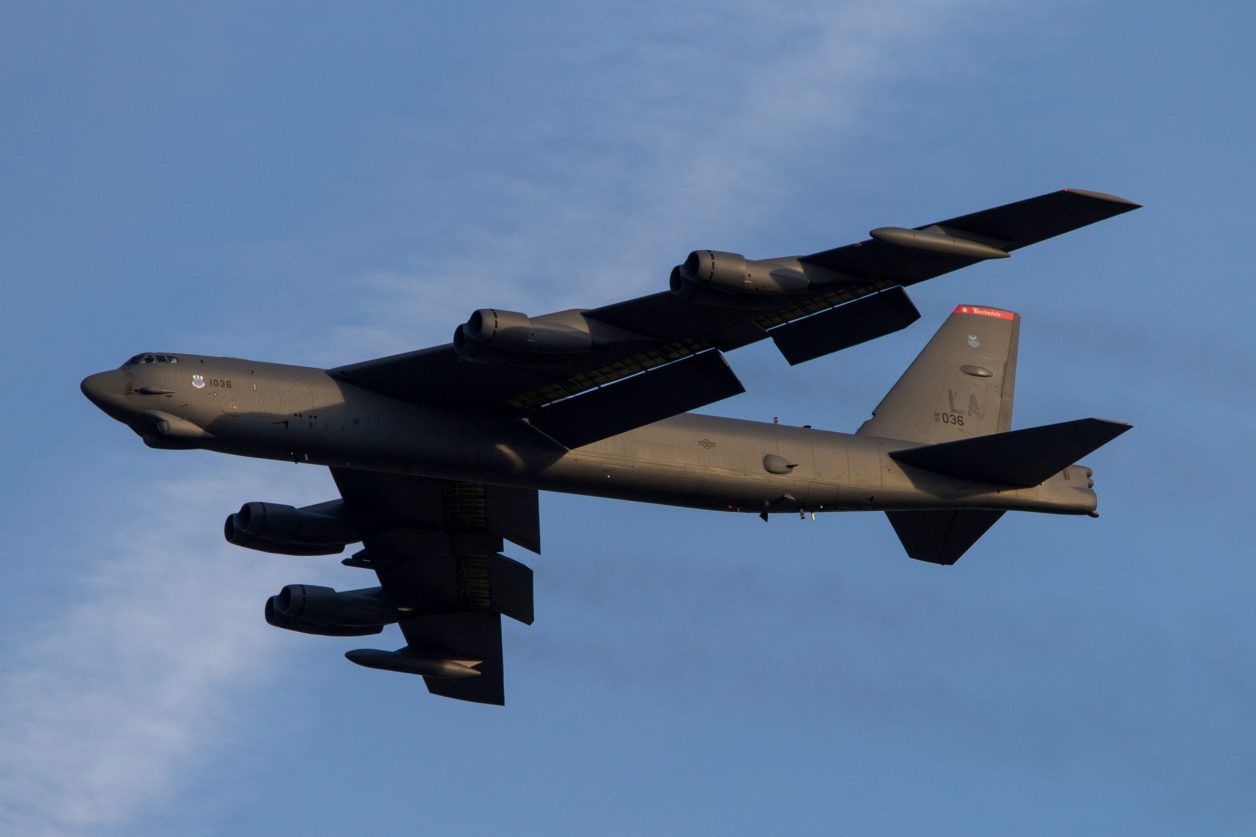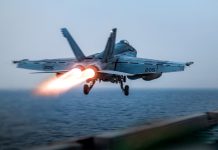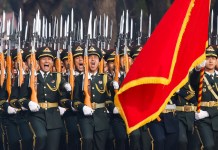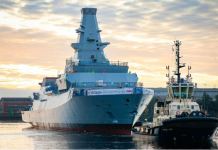The United States reportedly deployed three B-52 strategic bombers near Venezuela amid heightened tensions triggered by US military activity in the South Caribbean.
Three B-52s, designated BUNNY01, BUNNY02, and BUNNY03, were seen flying in international airspace off the coast of Venezuela. Following that, the bombers flew eastward to a section of international airspace in what Venezuela calls the Maiquetía Flight Information Region (FIR).
Earlier, other USAF assets deployed in the region, including the F-35 that flew from Puerto Rico, as well as aerial refueling tankers and other aircraft, have also been monitored in the same broad area.
Neither the US Southern Command (USSOUTHCOM) nor the US Air Force (USAF) officially announced the deployment. However, it comes amid a large-scale US military buildup in the South Caribbean, which has been launched to eliminate drug cartels that allegedly use the region as a transit corridor to the US.
The deployment includes destroyers, cruisers, and submarines, as well as aerial assets such as the MQ-9 Reaper drones, F-35 stealth fighters, and tankers.
The deployment of B-52 has been characterised as “a show of force” by observers, especially as it comes at a time when Trump has signalled that he would be willing to use force beyond the maritime strikes conducted in the region.
3x B52s (BUNNY01, BUNNY02, and BUNNY03) departed Barksdale AFB earlier today and left all their tracking devices on, likely as an intentional show of force, and patrolled off the coast of Venezuela earlier today…. ✈️#Venezuela #B52 #USAF pic.twitter.com/Be16snAgso
— Mrgunsngear (@Mrgunsngear) October 15, 2025
So far, the US has conducted five strikes on vessels that were allegedly transporting drugs, according to the US military. The strikes have killed 27 people in total, drawing widespread condemnation from international organizations.
Venezuela denies the vessels struck by the US military were involved in drug trafficking and accuses the US of using the strikes as a pretext for regime change in the country.
Defending the military action as a necessary step to stop the drug flow into the country, the Trump administration claimed earlier this month that the US and these drug cartels were now engaged in an “armed conflict.”
In fact, he further raised the stakes when he confirmed on October 15 that he had given a green light to the Central Intelligence Agency to conduct covert operations in Venezuela.
🇺🇸 🇻🇪 US President Donald Trump indicates he has authorized covert CIA action against Venezuela and said he was considering strikes against alleged drug cartels on land in the South American country.
➡️ https://t.co/F2kqlPexcU pic.twitter.com/LTIsGp3XZM— AFP News Agency (@AFP) October 16, 2025
Not just that, the US President said his administration was “looking at land” as it considers continued strikes in the region, implying that the US could conduct missile strikes on Venezuelan territory soon.
When asked if the CIA had the authority to assassinate Maduro, he said, “I think Venezuela is feeling the heat.”
Besides accusing Maduro of being one of the world’s largest drug traffickers, the head of the “Cartel of the Suns”, and a threat to US national security, the US President claimed that Venezuela had been releasing convicts into the United States, including those from mental health facilities. Experts have noted that there is no evidence to back these claims.
Venezuela has continued to push back against the US military’s high-handedness. Thousands of Venezuelans have joined a civilian militia in response to Maduro’s call for bolstering the cash-strapped country’s defenses. Many have taken part in weapons training held at military barracks and in neighborhoods.
Additionally, Venezuelan F-16 fighters earlier flew over US destroyers in the region, in what appears to be a signal of defiance to the US military.
Maduro has reportedly ordered military exercises and announced that he was mobilizing the military, police, and a civilian militia to defend Venezuela’s “mountains, coasts, schools, hospitals, factories, and markets.”
Against this backdrop, the deployment of B-52 bombers appears to be a move either aimed at deterring Venezuela or sounding the bugle of escalation.
A geopolitical analyst who goes by the name ‘The Informant’ on X argued that the flight pattern of the bombers indicated that “the exercise was a visible simulation of an approach and missile strike on Venezuelan targets. The overt nature suggests it served as a deliberate signal to Venezuelan observers.”
Meanwhile, some others pointed out that the deployment of the B-52 was a deliberate attempt at scaring Maduro, and noted how Venezuela could become the first target of the newly constituted Department of War.
Responding to the deployment, a non-profit people’s movement, ‘International People’s Assembly’ wrote on X: “The US is not carrying out an anti-narcotics operation, it’s terrorizing the Caribbean Sea and its population. 27 people have been killed by Trump’s airstrikes in the Caribbean thus far. The people of Venezuela have the right to sovereignty, free from imperial intimidation.”
The Unending Reign Of The B-52 Bombers
First flown in 1952, the B-52 entered US Air Force (USAF) service in 1955, making the oldest currently operational B-52s over 70 years old.
It is, thus, the oldest of three strategic bombers in the USAF inventory and a cornerstone of the USAF’s bomber fleet. About 76 B-52Hs are still in service, while another 12 are in reserve storage.
With its wingspan of 185 feet, the B-52 is a huge aircraft that accommodates a five-person crew of a pilot, co-pilot, weapon systems officer, navigator, and electronic warfare officer. It has an empty weight of 83,250 kilograms, a max take-off weight of 221,323 kilograms, and a fuel capacity of 181,610 liters.
Despite its age, the B-52 remains the USAF’s leading strategic nuclear and conventional weapons platform. It can carry more weapons than any other USAF jet and fly long-range missions from bases in the Pacific.
It can carry 32,000 kilograms of ordnance, including bombs, rockets, missiles, precision-guided weapons, air-launched cruise missiles, and miniature air-launched decoys, and fly at high subsonic speeds at altitudes of up to 50,000 feet (15,166.6 meters), beyond the range of naked eyesight. The lethal combination of payload and speed makes its attacks both physically and psychologically catastrophic.
Superior performance at high subsonic speeds and relatively low operating costs have kept them in service despite the development of more advanced strategic bombers, such as the variable-geometry Rockwell B-1 Lancer and the stealth Northrop Grumman B-2 Spirit.
The B-52 can be highly effective for ocean surveillance and can assist the Navy in anti-ship and mine-laying operations. For example, in two hours, a pair of B-52s can monitor 360,000 square kilometers of the ocean surface.

The B-52 gives the US conventional and nuclear global strike capability through stand-off weapons. In a conventional conflict, it can perform strategic attack, close-air support, air interdiction, offensive counter-air, and maritime operations. The B-52s played a great nuclear deterrent role during the Cold War and flew many air patrol missions near Warsaw Pact borders and seas near the Soviet Union.
The B-52s have seen action across diverse theatres and landscapes, ranging from the Vietnam War to the Gulf conflict.
As far as the latest Caribbean deployment is concerned, Venezuela has every reason to worry, as the B-52’s nuclear-capable status and 1,600-mile AGM-86 range put Venezuelan targets in reach, testing defenses without incursion.
In addition to carrying a variety of additional conventional weapons that can be used against targets on land and at sea, the bombers can also launch waves of standoff cruise missiles. Thus, making the aircraft more than suitable for launching strikes against a country like Venezuela.
If a conflict breaks out, the USAF could use the B-52 to neutralize Venezuelan air defenses, most acquired from the Soviet Union/Russia, before more extensive attacks are carried out.
The B-52s have participated in on-and-off counter-narcotics operations in the Caribbean sky for decades now. In recent times, the B-52s were deployed in the Middle East theatre to deter Iran and assist the US forces in anti-Houthi strikes.
- Contact the author at sakshi.tiwari13 (at) outlook.com
- Follow EurAsian Times on Google News




